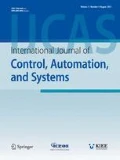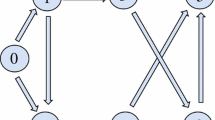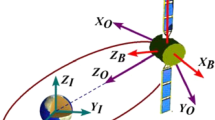Abstract
This paper studies the fixed-time stability of coordinated attitude tracking control under consideration of an input amplitude constraint. The attitude dynamics is described by rotation matrix, which avoids the unwinding phenomenon. By designing and analyzing the proposed nonsingular terminal sliding mode surfaces (NTSMSs) step by step, a novel saturated NTSMS is finally established. This NTSMS has theoretical and practical advantages over other existing NTSMSs, such as its fixed-time convergence property and boundedness. Based on it, two fixed-time coordinated controllers are developed. The first one effectively decreases the amplitude of the control input, whereas the second prevents saturation. Both controllers keep the attitude synchronization task be finished in fixed-time and provide better performance than existing controllers. Specific expressions of the regions to which the system states to converge are obtained using Lyapunov stability theory. Simulation results testify the correctness of the proposed theorems.
Similar content being viewed by others
References
J. Li and K. D. Kumar, “Decentralized fault-tolerant control for satellite attitude synchronization,” IEEE Transactions on Fuzzy Systems, vol. 20, no. 3, pp. 572–586, June 2012.
H. Du, S. Li, and C. Qian, “Finite-time attitude tracking control of spacecraft with application to attitude synchronization,” IEEE Transactions on Automatic Control, vol. 56, no. 11, pp. 2711–2717, November 2011.
A. M. Zou, K. D. Kumar, Z. G. Hou, and X. Liu, “Finite-time attitude tracking control for spacecraft using terminal sliding mode and Chebyshev neural network,” IEEE Transactions on Systems, Man, and Cybernetics, Part B: Cybernetics, vol. 41, no. 4, pp. 950–963, August 2011.
A. M. Zou and K. D. Kumar, “Distributed attitude coordination control for spacecraft formation flying,” IEEE Transactions on Aerospace and Electronic Systems, vol. 48, no. 2, pp. 1329–1346, April 2012.
S. Ganjefar, M. H. Sarajchi, and M. T. H. Beheshti, “Adaptive sliding mode controller design for nonlinear teleoperation systems using singular perturbation method,” Nonlinear Dynamics, vol. 81, no. 3, pp. 1435–1452, April 2015.
S. Ganjefar, M. H. Sarajchi, and S. M. Hoseini, “Teleoperation systems design using singular perturbation method and sliding mode controllers,” Journal of Dynamic Systems, Measurement, and Control, vol. 136, no. 5, September 2014.
S. T. Venkataraman and S. Gulati, “Terminal sliding modes: A new approach to nonlinear control synthesis,” Proc. of Fifth International Conference on Advanced Robotics, pp. 443–448, December 2002.
B. Wu, D. Wang, and E. K. Poh, “Decentralized robust adaptive control for attitude synchronization under directed communication topology,” Journal of Guidance, Control, and Dynamics, vol. 34, no. 4, pp. 1276–1282, May 2011.
Z. Man and X. H. Yu, “Terminal sliding mode control of MIMO linear systems,” IEEE Transactions on Circuits and Systems I: Fundamental Theory and Applications, vol. 44, no. 11, pp. 1065–1070, November 1997.
Y. Feng, X. Yu, and F. Han, “On nonsingular terminal sliding-mode control of nonlinear systems,” Automatica, vol. 49, no. 6, pp. 1715–1722, June 2013.
Y. Feng, X. Yu, and Z. Man, “Non-singular terminal sliding mode control of rigid manipulators,” Automatica, vol. 38, no. 12, pp. 2159–2167, December 2002.
S. Yu, X. Yu, B. Shirinzadeh, and Z. Man, “Continuous finite-time control for robotic manipulators with terminal sliding mode,” Automatica, vol. 41, no. 11, pp. 1957–1964, November 2005.
D. Zhao, S. Li, and F. Gao, “A new terminal sliding mode control for robotic manipulators,” IFAC Proceedings Volumes, vol. 41, no. 2, pp. 9888–9893, January 2008.
L. Yang and J. Yang, “Nonsingular fast terminal sliding-mode control for nonlinear dynamical systems,” International Journal of Robust and Nonlinear Control, vol. 21, no. 16, pp. 1865–1879, November 2011.
L. Wang, T. Chai, and L. Zhai, “Neural-network-based terminal sliding-mode control of robotic manipulators including actuator dynamics,” IEEE Transactions on Industrial Electronics, vol. 56, no. 9, pp. 3296–3304, September 2009.
Q. Zong, S. Shao, X. Zhang, D. Wang, and W. Liu, “Finite-time output feedback attitude tracking control for rigid spacecraft,” Harbin Gongye Daxue Xuebao/Journal Harbin Institute of Technology, vol. 49, no. 9, pp. 136–143, September 2017.
Y. Feng, X. Yu, and F. Han, “On nonsingular terminal sliding-mode control of nonlinear systems,” Automatica, vol. 49, no. 6, pp. 1715–1722, June 2013.
Z. Wang, Y. Su, and L. Zhang, “A new nonsingular terminal sliding mode control for rigid spacecraft attitude tracking,” Journal of Dynamic Systems, Measurement, and Control, vol. 140, no. 5, May 2018.
X. Zhang, Q. Zong, L. Dou, B. Tian, and W. Liu, “Finite-time attitude maneuvering and vibration suppression of flexible spacecraft,” Journal of the Franklin Institute, vol. 357, no. 16, pp. 11604–11628, November 2020.
Y. Guo, S.-M. Song, and Z. Yan, “Finite-time coordination control for formation flying spacecraft without unwinding,” Proceedings of the Institution of Mechanical Engineers, Part G: Journal of Aerospace Engineering, vol. 230, no. 1, pp. 172–188, January 2016.
B. Huang, A. Li, Y. Guo, and C. Wang, “Rotation matrix based finite-time attitude synchronization control for spacecraft with external disturbances,” ISA Transactions, vol. 85, pp. 141–150, February 2019.
M. Van, S. S. Ge, and H. Ren, “Finite time fault tolerant control for robot manipulators using time delay estimation and continuous nonsingular fast terminal sliding mode control,” IEEE Transactions on Cybernetics, vol. 47, no. 7, pp. 1681–1693, July 2017.
B. Li, K. Qin, B. Xiao, and Y. Yang, “Finite-time extended state observer based fault tolerant output feedback control for attitude stabilization,” ISA Transactions, vol. 91, pp. 11–20, August 2019.
E. Cruz-Zavala, J. A. Moreno, and L. M. Fridman, “Uniform robust exact differentiator,” IEEE Transactions on Automatic Control, vol. 56, no. 11, pp. 2727–2733, November 2011.
A. Polyakov, “Nonlinear feedback design for fixed-time stabilization of linear control systems,” IEEE Transactions on Automatic Control, vol. 57, no. 8, pp. 2106–2110, August 2012.
Z. Zuo, “Non-singular fixed-time terminal sliding mode control of non-linear systems,” IET Control Theory & Applications, vol. 9, no. 4, pp. 545–552, February 2015.
Z. Zuo, B. Tian, M. Defoort, and Z. Ding, “Fixed-time consensus tracking for multiagent systems with high-order integrator dynamics,” IEEE Transactions on Automatic Control, vol. 63, no. 2, pp. 563–570, February 2018.
Z. Zuo, “Nonsingular fixed-time consensus tracking for second-order multi-agent networks,” Automatica, vol. 54, pp. 305–309, April 2015.
D. Meng and Z. Zuo, “Signed-average consensus for networks of agents: A nonlinear fixed-time convergence protocol,” Nonlinear Dynamics, vol. 85, no. 1, pp. 155–165, February 2016.
M. L. Corradini and A. Cristofaro, “Nonsingular terminal sliding-mode control of nonlinear planar systems with global fixed-time stability guarantees,” Automatica, vol. 95, pp. 561–565, September 2018.
X. Jin, “Adaptive fixed-time control for MIMO nonlinear systems with asymmetric output constraints using universal barrier functions,” IEEE Transactions on Automatic Control, vol. 64, no. 7, pp. 3046–3053, July 2019.
Y. Wang and Y. Song, “Leader-following control of highorder multi-agent systems under directed graphs: Prespecified finite time approach,” Automatica, vol. 87, pp. 113–120, January 2018.
Y. Wang, Y. Song, D. J. Hill, and M. Krstic, “Prescribed-time consensus and containment control of networked multiagent systems,” IEEE Transactions on Cybernetics, vol. 49, no. 4, pp. 1138–1147, April 2019.
B. Huang, A. Li, Y. Guo, and C. Wang, “Fixed-time attitude tracking control for spacecraft without unwinding,” Acta Astronautica, vol. 151, pp. 818–827, October 2018.
Y. Huang and Y. Jia, “Adaptive fixed-time six-DOF tracking control for noncooperative spacecraft fly-around mission,” IEEE Transactions on Control Systems Technology, vol. 27, no. 4, pp. 1796–1804, July 2019.
M. Golestani, S. M. Esmaeilzadeh, and S. Mobayen, “Fixed-time control for high-precision attitude stabilization of flexible spacecraft,” European Journal of Control, vol. 57, pp. 222–231, January 2021.
M. Zhuang, L. Tan, and S. Song, “Fixed-time attitude coordination control for spacecraft with external disturbance,” ISA Transactions, vol. 114, pp. 150–170, August 2021.
Q. Hu, X. Tan, and M. R. Akella, “Finite-time fault-tolerant spacecraft attitude control with torque saturation,” Journal of Guidance, Control, and Dynamics, vol. 40, no. 10, pp. 2524–2537, October 2017.
A. M. Zou, K. D. Kumar, and A. H. J. de Ruiter, “Finite-time spacecraft attitude control under input magnitude and rate saturation,” Nonlinear Dynamics, vol. 99, no. 3, pp. 2201–2217, February 2020.
H. T. Chen, S. M. Song, and Z. Bin Zhu, “Robust finite-time attitude tracking control of rigid spacecraft under actuator saturation,” International Journal of Control, Automation, and Systems, vol. 16, no. 1, pp. 1–15, February 2018.
J. Zhou, Y. Cheng, H. Du, D. Wu, M. Zhu, and X. Lin, “Active finite-time disturbance rejection control for attitude tracking of quad-rotor under input saturation,” Journal of the Franklin Institute, vol. 357, no. 16, pp. 11153–11170, November 2020.
S. M. Amrr and M. Nabi, “Finite-time fault tolerant attitude tracking control of spacecraft using robust nonlinear disturbance observer with anti-unwinding approach,” Advances in Space Research, vol. 66, no. 7, pp. 1659–1671, October 2020.
X. Liang, Q. Wang, C. Hu, and C. Dong, “Fixed-time observer based fault tolerant attitude control for reusable launch vehicle with actuator faults,” Aerospace Science and Technology, vol. 107, p. 106314, December 2020.
J. Fu, M. Liu, X. Cao, and A. Li, “Robust neural-network-based quasi-sliding-mode control for spacecraft-attitude maneuvering with prescribed performance,” Aerospace Science and Technology, vol. 112, p. 106667, May 2021.
N. Zhou, Y. Kawano, and M. Cao, “Neural network-based adaptive control for spacecraft under actuator failures and input saturations,” IEEE Transactions on Neural Networks and Learning Systems, vol. 31, no. 9, pp. 3696–3710, September 2020.
L. Xing, J. Zhang, C. Liu, and X. Zhang, “Fuzzy-logic-based adaptive event-triggered sliding mode control for spacecraft attitude tracking,” Aerospace Science and Technology, vol. 108, p. 106394, January 2021.
E. Liu, Y. Yang, and Y. Yan, “Spacecraft attitude tracking for space debris removal using adaptive fuzzy sliding mode control,” Aerospace Science and Technology, vol. 107, p. 106310, December 2020.
Y. Dong, L. You, X. Bing, and L. Wene, “Robust finite-time adaptive control algorithm for satellite fast attitude maneuver,” Journal of the Franklin Institute, vol. 357, no. 16, pp. 11558–11583, November 2020.
M. Golestani, S. M. Esmaeilzadeh, and B. Xiao, “Fault-tolerant attitude control for flexible spacecraft subject to input and state constraint,” Transactions of the Institute of Measurement and Control, vol. 42, no. 14, pp. 2660–2674, October 2020.
X. Lin, X. Shi, and S. Li, “Adaptive tracking control for spacecraft formation flying system via modified fast integral terminal sliding mode surface,” IEEE Access, vol. 8, pp. 198357–198367, November 2020.
Y. Guo, J. Guo, and S. Song, “Backstepping control for attitude tracking of the spacecraft under input saturation,” Acta Astronautica, vol. 138, pp. 318–325, September 2017.
K. Lu, Y. Xia, and M. Fu, “Controller design for rigid spacecraft attitude tracking with actuator saturation,” Information Sciences, vol. 220, pp. 343–366, January 2013.
Q. Hu, “Robust adaptive sliding mode attitude maneuvering and vibration damping of three-axis-stabilized flexible spacecraft with actuator saturation limits,” Nonlinear Dynamics, vol. 55, no. 4, pp. 301–321, March 2009.
T. Lee, “Exponential stability of an attitude tracking control system on SO(3) for large-angle rotational maneuvers,” Systems & Control Letters, vol. 61, no. 1, pp. 231–237, January 2012.
Z. Zuo and L. Tie, “A new class of finite-time nonlinear consensus protocols for multi-agent systems,” International Journal of Control, vol. 87, no. 2, pp. 363–370, February 2014.
S. Ding and W. X. Zheng, “Nonsingular terminal sliding mode control of nonlinear second-order systems with input saturation,” International Journal of Robust and Nonlinear Control, vol. 26, no. 9, pp. 1857–1872, June 2016.
Y. Xia, Z. Zhu, M. Fu, and S. Wang, “Attitude tracking of rigid spacecraft with bounded disturbances,” IEEE Transactions on Industrial Electronics, vol. 58, no. 2, pp. 647–659, February 2011.
Author information
Authors and Affiliations
Corresponding author
Additional information
Publisher’s Note Springer Nature remains neutral with regard to jurisdictional claims in published maps and institutional affiliations.
This paper was supported by the Major Program of Natural Science Foundation of China (61690210) and National Natural Science Foundation of China (6191101340).
Ming-Lei Zhuang received his B.S. degree in the School of Automation from Central South University, and an M.S. degree in the College of Information Science and Engineering from Northeastern University. Currently, he is a Ph.D. student in the School of Astronautics in Harbin Institute of Technology. His main research interests include multi-agent system formation control, time-delay system, sliding mode control, and adaptive control.
Shen-Min Song received his Ph.D. degree in control theory and application from Harbin Institute of Technology in 1996. He carried out postdoctoral research at Tokyo University from 2000 to 2002. He is currently a professor in the School of Astronautics at Harbin Institute of Technology. His main research interests include spacecraft guidance and control, intelligent control, and nonlinear theory and application.
Rights and permissions
About this article
Cite this article
Zhuang, ML., Song, SM. Fixed-time Coordinated Attitude Tracking Control for Spacecraft Formation Flying Considering Input Amplitude Constraint. Int. J. Control Autom. Syst. 20, 2129–2147 (2022). https://doi.org/10.1007/s12555-021-0366-8
Received:
Revised:
Accepted:
Published:
Issue Date:
DOI: https://doi.org/10.1007/s12555-021-0366-8




